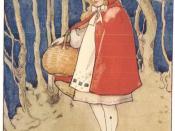The timeless old tale of a little girl meeting a wolf on her way to granny's house has been passed down through oral tradition from one generation to the next. Little Red Riding Hood has existed for centuries and has even predated the first literary version put forward by Charles Perrault in 1697. Since then, this story is continually being told to children and society has seen many adaptations including Jordan and Carter's controversial "The Company of Wolves." Be it presented as literature, oral storytelling, or cinematography these sources have one theme in common: they tell a cautionary tale of the warnings of entering adolescence. In comparing the historical, sexual, and moral aspects of Perrault's "Little Red Riding Hood," France's "The False Grandmother," and Jordan's "The Company of Wolves, readers are left appreciating the different means used in communicating the warnings of entering adolescence.
Oral stories are quite different from those of common literature. In France's oral version there is little time spent on focusing on detail in terms of an introduction to the story and setting. Instead, this oral version quickly jumps to the girl's encounter with the wolf. This happens all within the first sentence: "Once upon a time a girl was walking through the woods with a basket of goodies for her grandmother, when she met a wolf." Since these stories were told orally, there is most likely no need for a significant amount of detail simply because this was not the focus of the performance. As well, these types of stories are not read but seen and heard by the audience. What is significantly different about an oral story is that there is a heavy reliance on the storyteller to deliver a captivating performance, meaning that the action of the...


